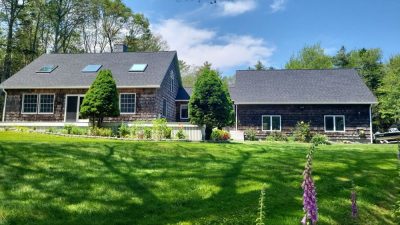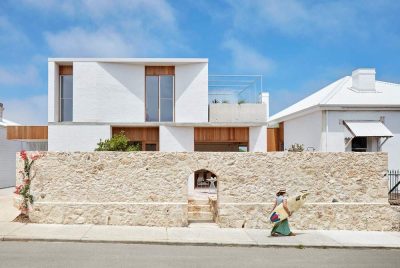Walking through spaces adorned with botanical artistry reveals humanity’s enduring connection to natural beauty. Flower motifs transcend cultural boundaries and historical periods, appearing consistently across civilizations as symbols of growth, renewal, and aesthetic refinement. Interior environments benefit from this universal appeal, creating atmospheres that nurture both visual pleasure and emotional well-being.
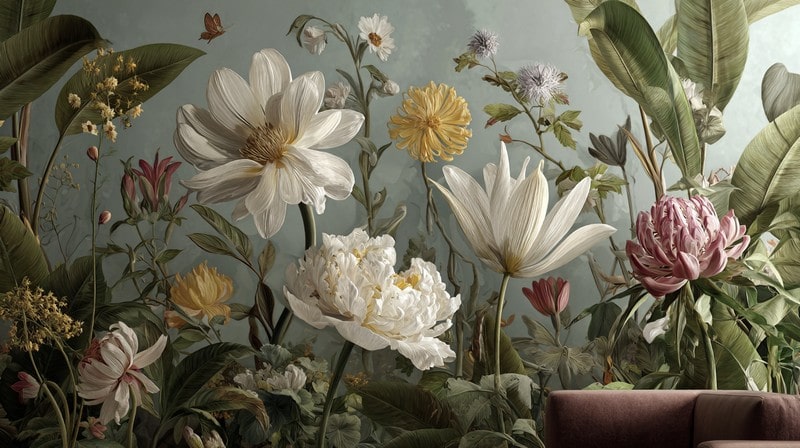
Professional expertise becomes essential when selecting a mural artist for hire who understands the complexities of translating three-dimensional botanical subjects onto two-dimensional wall surfaces. The process requires technical skill, artistic vision, and comprehensive knowledge of both horticultural accuracy and interior design principles. Successful flower mural projects result from collaboration between knowledgeable clients and qualified creative professionals who can create unique environments that reflect personal taste and lifestyle preferences while providing both immediate aesthetic enhancement and long-term property value improvement.
The Renaissance of Botanical Wall Art
Contemporary lifestyle pressures have intensified the human need for peaceful retreat environments within residential spaces. Flower murals answer this desire by transforming ordinary rooms into tranquil botanical sanctuaries that provide psychological refuge and visual respite from daily stressors. Modern technology paradoxically drives people to seek organic, tactile experiences within their living spaces, fueling remarkable growth in demand for authentic botanical artistry over mass-produced alternatives.
Traditional floral wallpaper relied on repetitive patterns that created visual uniformity and limited customization options. Contemporary botanical murals eliminate these restrictions while providing unlimited creative possibilities. Hand-painted flower murals respond to specific architectural conditions, room dimensions, and lighting characteristics, with artists adjusting compositions, colors, and scale to complement existing interior elements rather than competing for attention.

The Psychology of Floral Imagery in Living Spaces
Biophilic design principles recognize fundamental human needs for natural connections that persist despite urban lifestyle adaptations. Flower imagery satisfies these evolutionary requirements through visual stimulation that triggers positive neurological responses and stress reduction mechanisms. Interior spaces incorporating botanical themes feel more comfortable and welcoming than those lacking natural references.
Color psychology research reveals specific emotional responses to different floral hues and combinations. Warm flower colors energize and stimulate social interaction, while cool botanical tones promote relaxation and contemplation. Professional artists understand these relationships and design compositions that support intended room functions and atmospheric goals.
Cultural and Historical Significance of Flower Motifs
Botanical themes appear throughout art history as symbols carrying complex cultural meanings beyond mere decoration. Different civilizations assigned spiritual, medicinal, and social significance to specific flowers, creating rich symbolic vocabularies that inform contemporary mural design. European aristocratic traditions established flowers as symbols of refinement and social status, while Asian artistic traditions emphasize seasonal flower progressions as metaphors for life cycles and natural harmony. These cultural references add depth and meaning to flower mural compositions.
Botanical Mural Style Categories and Approaches
Understanding different stylistic approaches enables property owners to select flower mural treatments that align with architectural contexts and personal preferences. Each category offers distinct visual characteristics and requires specific technical approaches that influence both aesthetic outcomes and project requirements.
Photorealistic Botanical Reproduction
Hyperrealistic flower painting demands exceptional technical skill and comprehensive knowledge of botanical structures. Artists study living specimens, photographic references, and scientific illustrations to achieve accuracy levels that satisfy sophisticated viewers. Accurate flower representation requires understanding of plant anatomy, growth patterns, and species-specific characteristics, with professional botanical artists studying horticultural science to render authentic details, including leaf venation, petal structures, and reproductive organs.
Authentic flower colors challenge even experienced artists due to subtle variations, transparency effects, and changing light conditions. Natural flower pigments create complex color relationships that require sophisticated mixing techniques and premium paint formulations. Seasonal color variations within individual flower species require careful observation and documentation, with professional artists incorporating these subtleties to create compositions that reflect natural timing and biological authenticity.
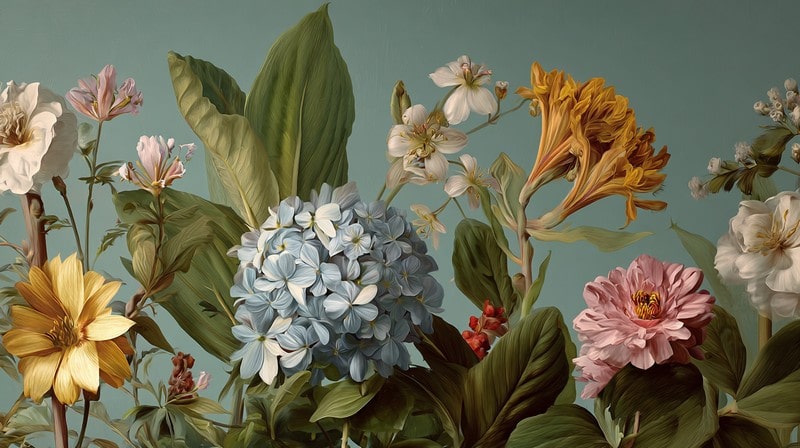
Realistic flower textures require layered painting techniques that build surface complexity through multiple applications. Petal softness contrasts with stem firmness and leaf surfaces, creating tactile impressions that enhance three-dimensional illusions. Surface preparation influences achievable texture effects, with smooth wall surfaces enabling fine detail work while textured surfaces may require modified approaches.
Impressionistic and Artistic Interpretation
Impressionistic flower murals prioritize color relationships, atmospheric effects, and emotional responses over precise botanical accuracy. This approach offers creative flexibility while maintaining recognizable floral themes that satisfy diverse aesthetic preferences. Visible brushwork becomes an integral design element, creating energy and movement that static reproduction cannot achieve.

Color blending occurs directly on wall surfaces rather than pre-mixing on palettes, creating spontaneous effects and subtle variations. These methods require confident execution and cannot be easily corrected once applied. Impressionistic techniques excel at suggesting seasonal progressions through color temperature variations, atmospheric density, and compositional energy levels, with lighting effects playing crucial roles in seasonal interpretation.
Contemporary Minimalist Floral Design
Modern minimalist approaches emphasize essential elements while eliminating decorative complexity that might overwhelm contemporary interior schemes. This philosophy aligns with current design trends toward simplified forms, neutral color palettes, and sophisticated restraint. Geometric interpretation of flower forms reduces natural complexity to essential structural relationships and mathematical proportions, creating sophisticated artworks that complement contemporary architecture while maintaining botanical associations.
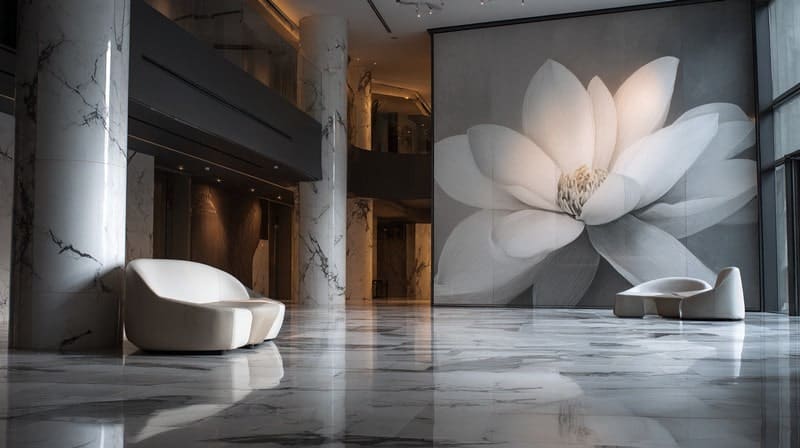
Single-color flower murals create sophisticated effects through value relationships, texture variations, and subtle hue modifications within limited palettes. Material variations, including matte and gloss finishes, create surface interest and light reflection differences that enhance monochromatic compositions. Oversized individual flower portraits create dramatic focal points and architectural statements that transform entire wall surfaces into artistic features.
Room-Specific Flower Mural Applications
Different interior spaces benefit from tailored flower mural approaches that consider room function, lighting conditions, and intended atmospheric effects. Professional artists evaluate room proportions, lighting conditions, and usage patterns to recommend optimal floral treatments that enhance rather than dominate interior environments.
Bedroom Sanctuaries and Floral Serenity
Bedroom flower murals promote rest through calming botanical imagery that reduces stress and supports healthy sleep patterns. Color selections emphasize soothing tones that complement circadian rhythms while avoiding overly stimulating elements. Luxury master suites benefit from sophisticated floral treatments that create private sanctuaries, while guest bedroom murals create welcoming atmospheres with universal appeal. Children’s bedroom flower murals combine aesthetic appeal with educational value through age-appropriate botanical representation and interactive discovery opportunities.
Social Spaces and Entertaining Areas
Living areas benefit from flower murals that serve as conversation pieces and focal points while creating welcoming atmospheres for gatherings. Dining room flower murals enhance meal experiences through sophisticated botanical imagery that creates pleasant backdrops for conversation, with color selections emphasizing appetite-friendly hues while maintaining visual interest. Great rooms can accommodate dramatic flower murals that create major visual statements, while entrance hall murals create welcoming first impressions that set positive tones for entire home experiences.
Private Wellness and Retreat Spaces
Personal wellness areas benefit from therapeutic flower imagery that supports health and relaxation activities. Bathroom flower murals transform utilitarian spaces into spa-like retreats, requiring moisture-resistant materials in humid environments. Home office flower murals help reduce work-related stress while promoting productivity through natural imagery, with color psychology considerations influencing palette selection to support alertness and focus. Reading areas benefit from contemplative flower themes that promote concentration while providing visual relief during quiet activities.
Design Principles for Flower Wall Murals
Successful flower mural projects require an understanding of fundamental design principles that govern color relationships, composition, and spatial impact. A professional application distinguishes superior results while ensuring optimal integration with architectural and interior design elements.
Color Theory and Floral Palette Selection
Professional color approaches require an understanding of natural botanical color relationships, seasonal variations, and psychological effects. Creating pleasing color combinations draws from natural botanical palettes where related hues create inherently satisfying visual relationships. Analogous color schemes create gentle transitions that promote relaxation, while complementary relationships provide dynamic contrast that energizes compositions.
Designing murals that reflect natural seasonal changes enables year-round visual interest while connecting interior spaces with natural cycles. Color temperature relationships create seasonal associations without temporal restrictions, ensuring long-term satisfaction. Integrating flower colors with existing décor requires an understanding of relationships between botanical elements and architectural features, furniture, and other interior components.
Composition and Visual Balance
Principles of arranging floral elements effectively create compositions that direct attention, maintain visual interest, and support spatial relationships. Sizing flowers appropriately requires an understanding of viewing distances, room dimensions, and human visual perception. Mathematical relationships, including golden ratio proportions, create inherently pleasing spatial divisions that enhance compositional satisfaction.
Directing attention through compositional techniques enables artists to create visual hierarchies that guide the viewer’s experience while maintaining balanced arrangements. Using space effectively creates breathing room that prevents overwhelming complexity while allowing individual elements to receive appropriate attention. Background treatments must support rather than compete with floral elements while providing appropriate atmospheric contexts.
Lighting Considerations and Environmental Factors
Understanding how lighting affects flower mural appearance requires an understanding of illumination effects on color perception throughout daily and seasonal cycles. Optimizing murals for changing daylight conditions involves understanding color temperature variations and intensity fluctuations that affect botanical color appearance. Different artificial lighting types affect color appearance through various color temperature characteristics, requiring consideration during color development phases.
Botanical Accuracy and Horticultural Authenticity
Professional flower murals benefit from understanding botanical principles and horticultural accuracy that ensure authentic representation, appealing to sophisticated viewers and garden enthusiasts. Scientific accuracy extends beyond visual appearance to include appropriate growth patterns, seasonal timing, and ecological relationships that occur in actual garden environments.
Species Selection and Regional Appropriateness
Choosing flowers appropriate for the local climate and culture creates authentic representations that connect interior spaces with regional horticultural heritage. Using indigenous flowers creates authentic regional connections that demonstrate local environmental heritage while providing educational opportunities about native plant communities. Incorporating international floral varieties enables global garden themes while maintaining botanical accuracy, though cultural appropriateness requires sensitivity when using flowers with specific cultural significance.
Representing flowers accurately through their natural cycles requires an understanding of bloom timing, growth stages, and seasonal development. Companion planting relationships demonstrate ecological awareness while creating realistic garden compositions that reflect actual horticultural practices. Understanding garden design principles enables artists to create murals that reflect actual gardening knowledge while appealing to experienced gardeners.
Technical Execution and Professional Methods
Creating superior flower murals requires specialized techniques, premium materials, and professional expertise that distinguish quality results from amateur attempts. Professional execution involves systematic approaches to surface preparation, paint application, and finishing techniques that protect artistic investment while achieving intended visual effects.
Surface Preparation for Botanical Artistry
Foundation work essential for flower mural success includes wall evaluation, texture modification, and primer application that create optimal conditions for detailed botanical artwork. Preparing surfaces for detailed floral work requires achieving appropriate smoothness levels that enable fine brush control and subtle color transitions. Protecting murals in humid environments requires moisture-resistant primer systems and protective topcoats that prevent deterioration while maintaining artistic quality.
Professional Painting Techniques and Tools
Methods and equipment used by professional artists enable superior results through specialized brush selection, paint application techniques, and quality control procedures. Choosing appropriate brushes for various flower features requires an understanding of brush characteristics and their effects on paint application. Building up floral images through multiple paint layers creates depth and complexity impossible to achieve through single applications.
Professional approaches to achieving accurate floral colors require an understanding of pigment properties, color theory, and mixing techniques that enable precise color reproduction. Archival paint quality ensures museum-standard permanence and color stability that protects artistic investment through superior material performance and extended service life.
The Value Proposition of Professional Flower Murals
Flower murals represent significant investments that provide both immediate aesthetic satisfaction and long-term property enhancement. Professional flower murals offer advantages over temporary decorating solutions through permanence, uniqueness, and appreciation potential that justify initial investment costs.
Investment Returns and Property Value Enhancement
Financial benefits include real estate market appeal, differentiation advantages, and long-term durability that affect property values and marketability. Quality artwork appeals to sophisticated buyers while demonstrating permanent property improvements. Luxury market positioning benefits from custom artistic features that distinguish properties while demonstrating owner investment in permanent improvements.
Comparing murals to wallpaper reveals significant durability advantages through professional materials and execution methods. Quality flower murals maintain their appearance for decades, whereas wallpaper requires periodic replacement. Unique design solutions provide advantages impossible to achieve through manufactured products, with custom murals adapting to specific architectural features while reflecting personal preferences.
Psychological and Lifestyle Benefits
Personal advantages include stress reduction, environmental connection, and aesthetic pleasure that justify artistic investment through improved quality of life. Health benefits of floral imagery include documented psychological advantages through nature connection and visual pleasure that affect overall well-being. Maintaining botanical beauty regardless of season provides consistent visual pleasure and a natural connection that outdoor gardens cannot match.
Maintenance and Preservation of Flower Murals
Proper care and maintenance ensure flower murals retain beauty and value over time while protecting artistic investment through appropriate preservation methods. Understanding preservation requirements enables planning and budget allocation for artistic asset protection.
Routine Care and Cleaning Protocols
Day-to-day maintenance involves simple procedures that homeowners can perform safely while protecting artistic surfaces from damage. Protecting murals from accumulating particles requires regular dusting using appropriate tools and techniques that remove soil without damaging delicate paint surfaces. Safe methods for maintaining mural appearance include approved cleaning materials and techniques that remove soil without compromising paint integrity.
Long-term Preservation Strategies
Professional conservation approaches include systematic care protocols, environmental monitoring, and expert services that ensure continued artistic quality while protecting investment value. Protecting flower murals from light damage requires an understanding of ultraviolet radiation effects and protective measures that maintain color integrity while providing adequate illumination. Window treatments and UV-filtering systems protect artistic surfaces from solar damage while maintaining pleasant natural lighting.
Professional conservation service benefits include specialized knowledge, appropriate materials, and conservation techniques that maintain artistic integrity while protecting investment value. Documentation and maintenance records provide valuable information for future care and restoration work while supporting insurance valuations and investment protection.
Selecting Professional Artists and Project Management
Successful flower mural projects require careful artist selection and professional project management that ensure optimal results and client satisfaction. Artist qualifications for flower mural work require specialized botanical painting expertise and understanding of horticultural accuracy that distinguishes qualified professionals from general decorative painters.
Artist Qualification and Portfolio Assessment
Evaluating professionals for botanical mural projects requires an understanding of relevant experience, technical skills, and artistic capabilities that enable successful flower painting execution. Identifying artists with relevant flower painting expertise ensures appropriate capabilities for complex botanical work requiring species accuracy, color precision, and compositional sophistication. Portfolio evaluation focuses on botanical accuracy, color quality, and compositional sophistication that demonstrate professional capabilities.
Assessing artistic capabilities for complex floral work includes drawing skills, color mixing expertise, and detail rendering abilities that determine the project’s success potential. Client references and project documentation verify professional track records and satisfaction levels while revealing working methods and service quality.
Project Planning and Timeline Development
Managing flower mural creation from concept to completion requires systematic approaches that ensure client satisfaction while maintaining artistic quality standards. Collaborative creation of final mural designs involves consultation, concept development, and approval stages that ensure client vision alignment while leveraging professional expertise for optimal results.
Financial planning includes cost factors, payment schedules, and warranty considerations that protect investment while ensuring satisfactory outcomes. Quality assurance measures and service agreements provide investment protection through professional standards, warranty coverage, and ongoing support that ensure continued satisfaction and artistic value preservation.


